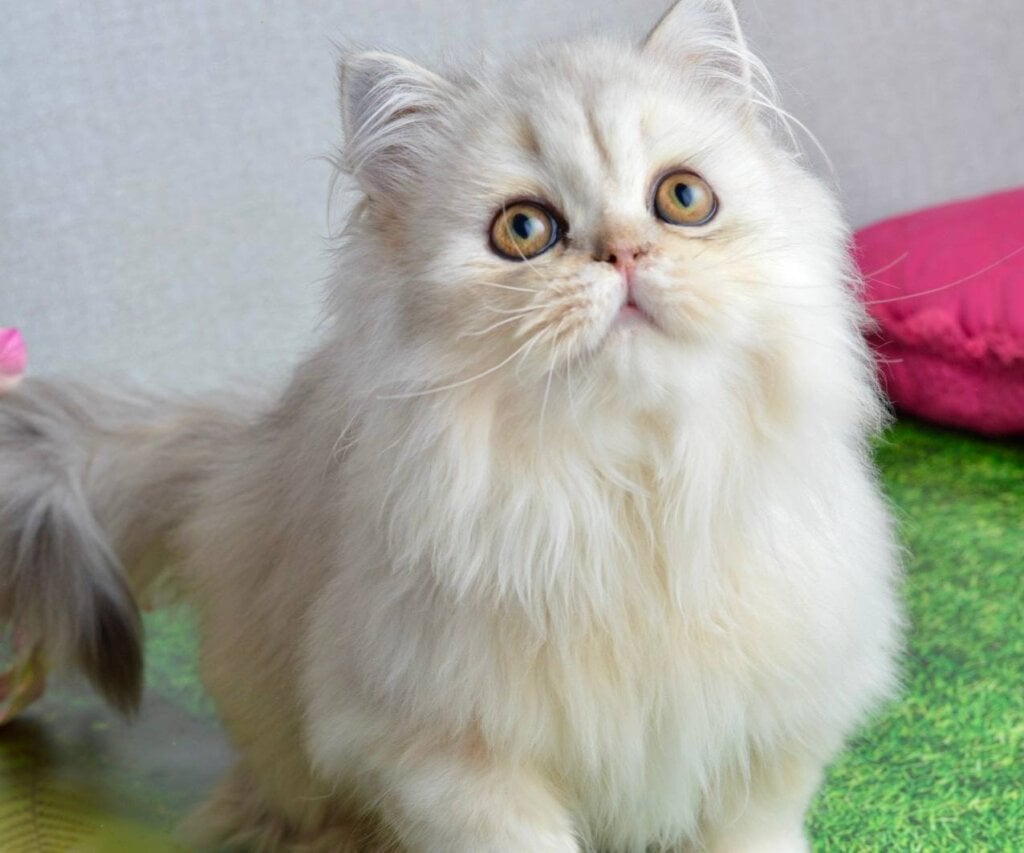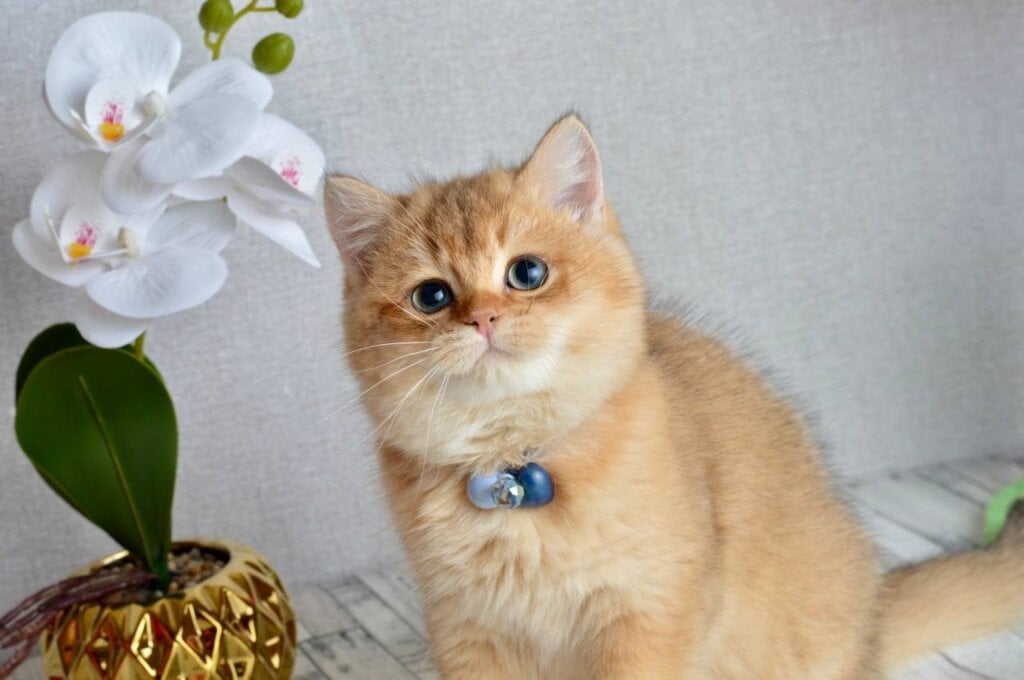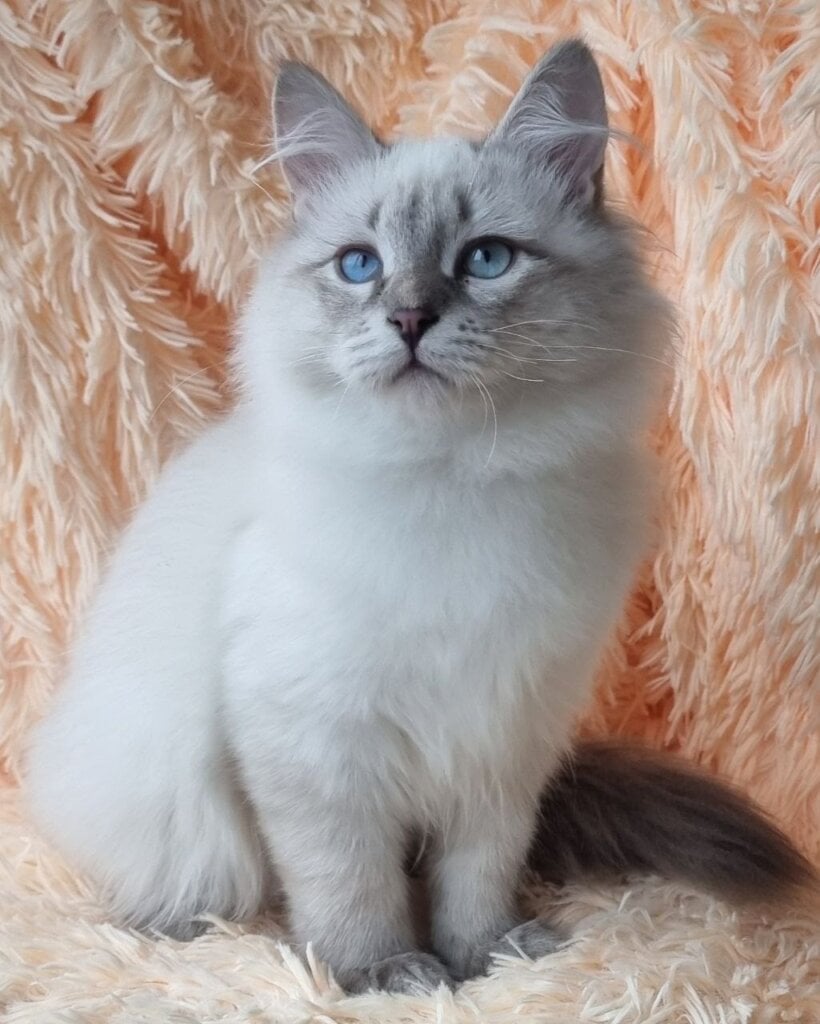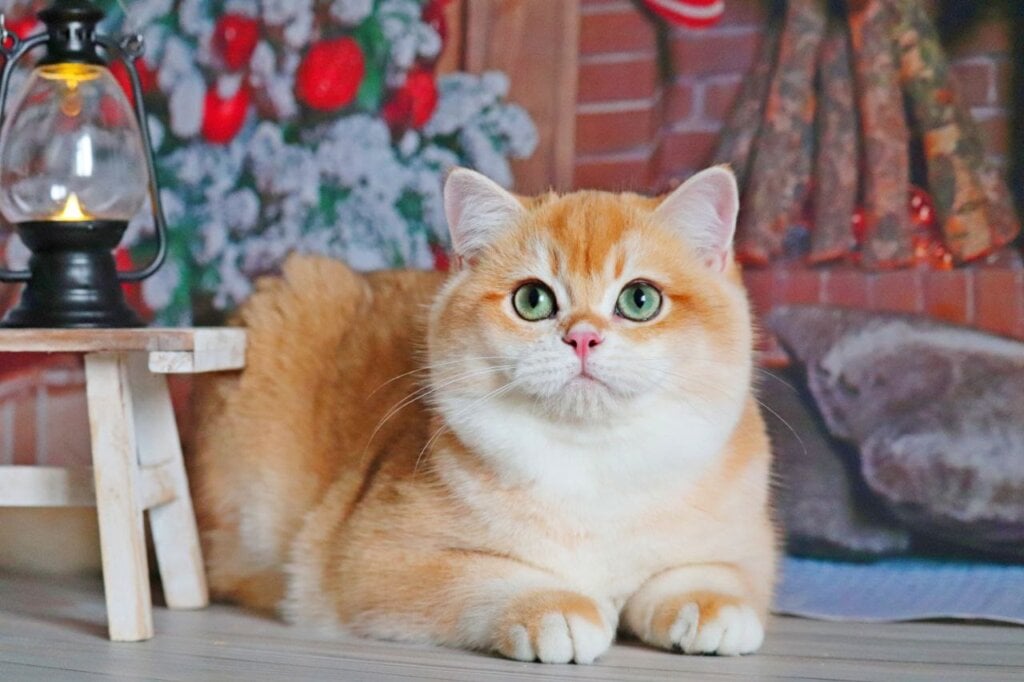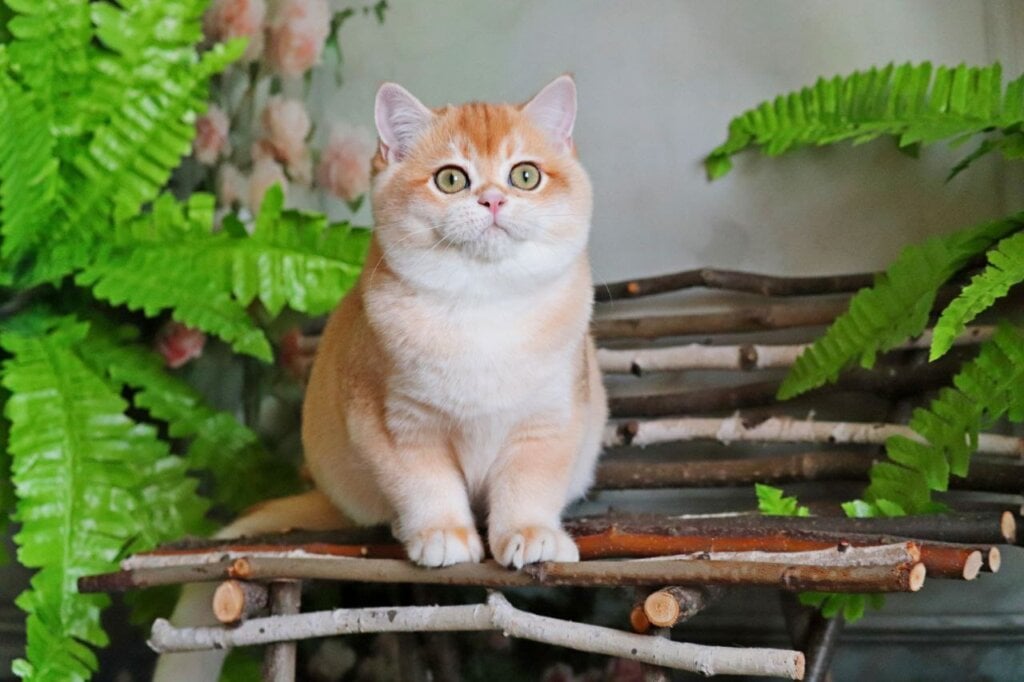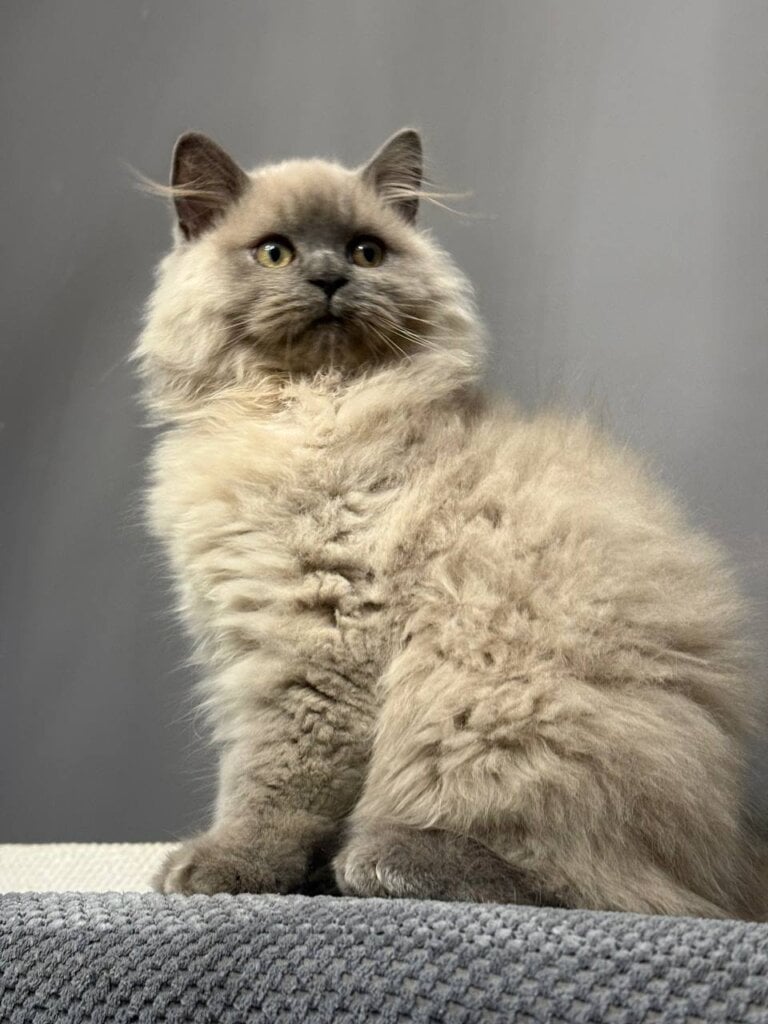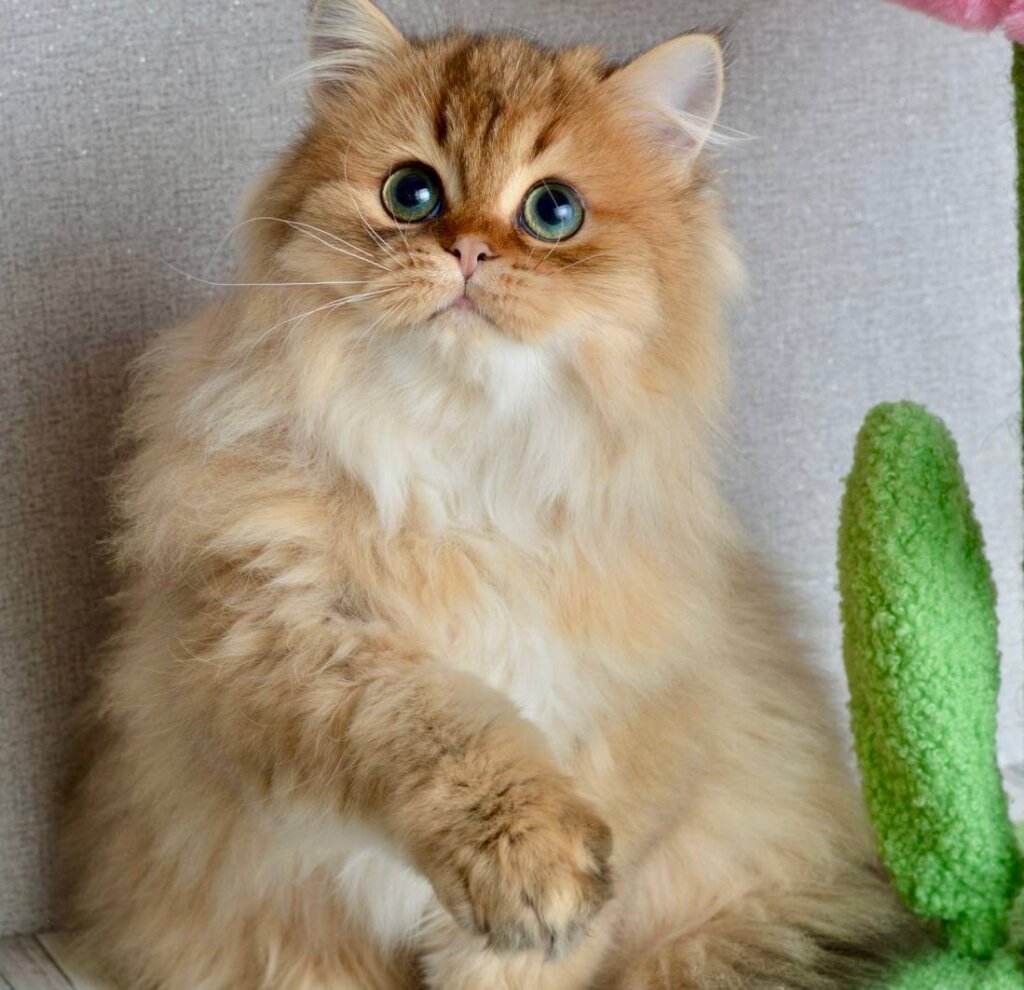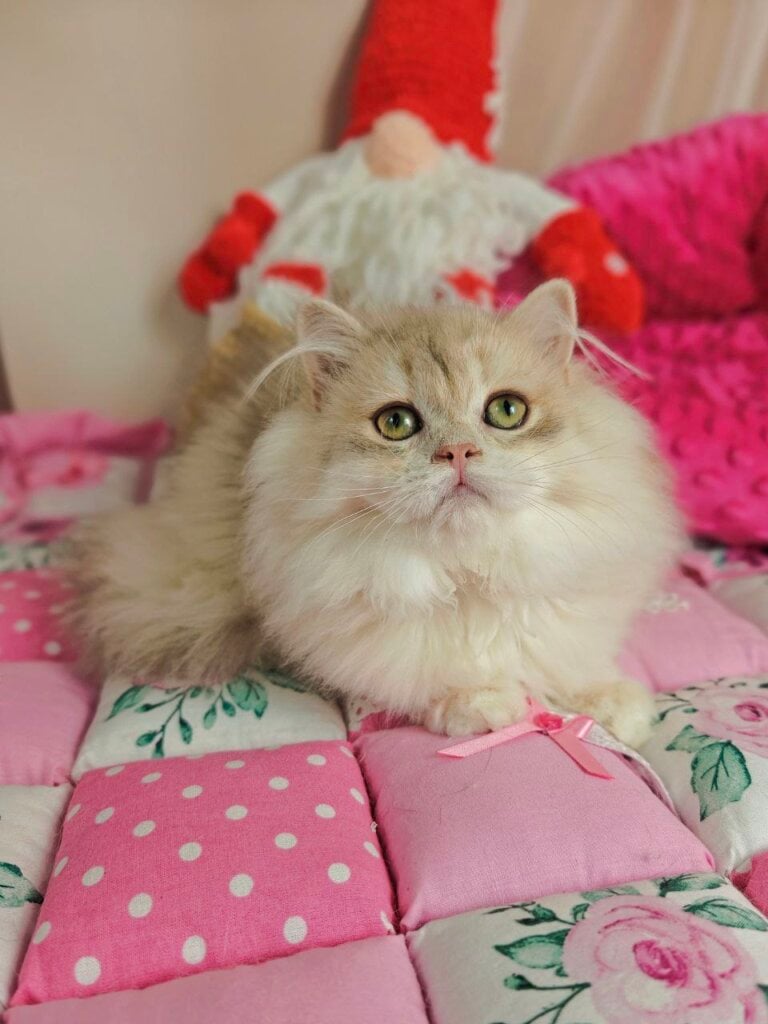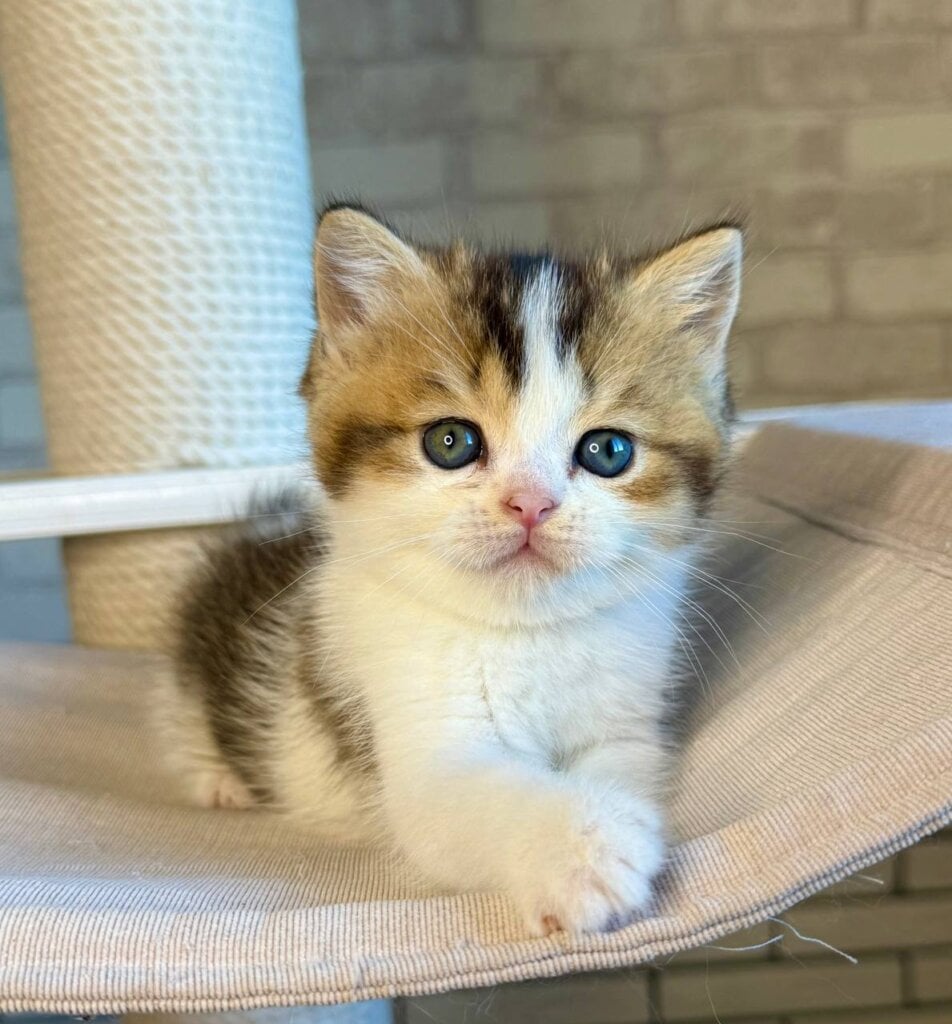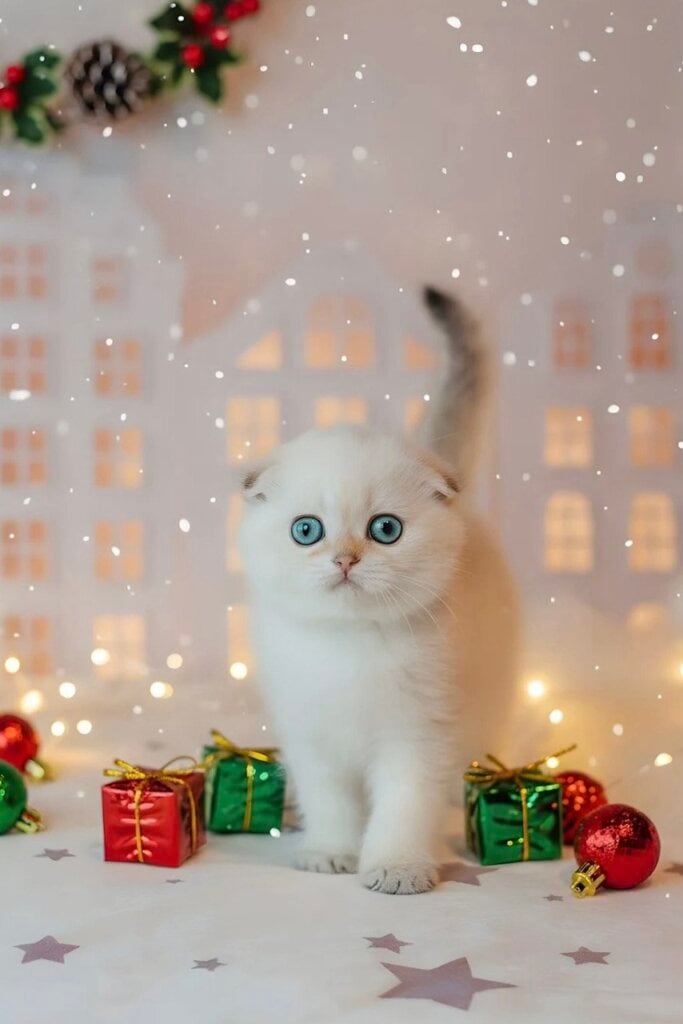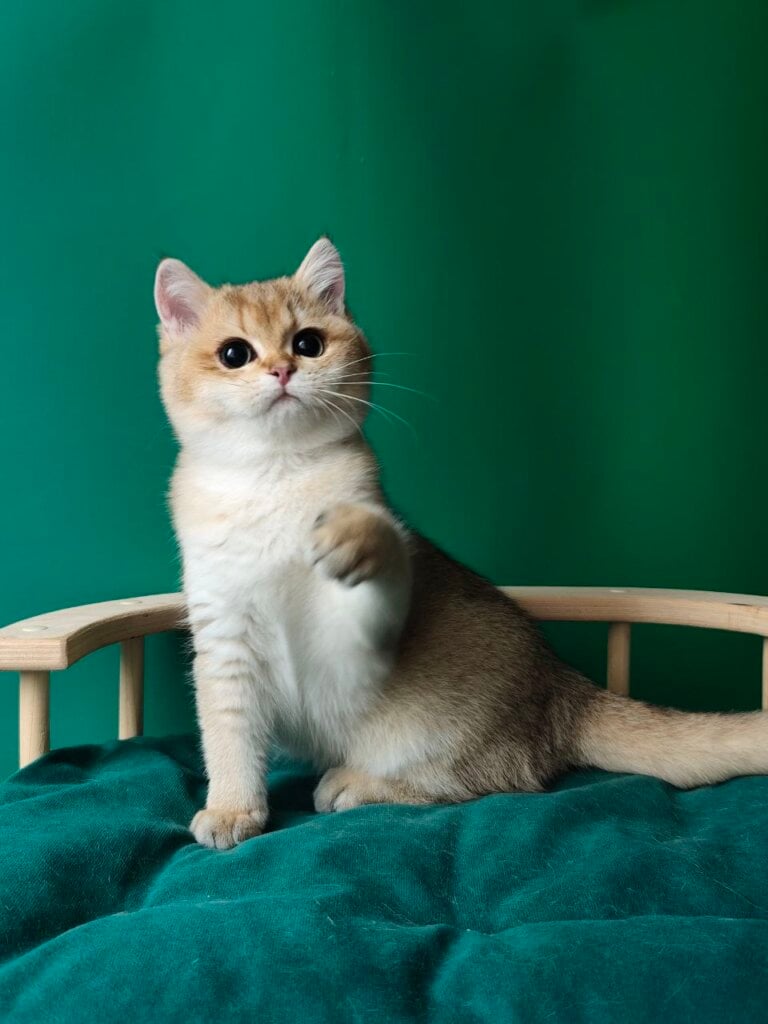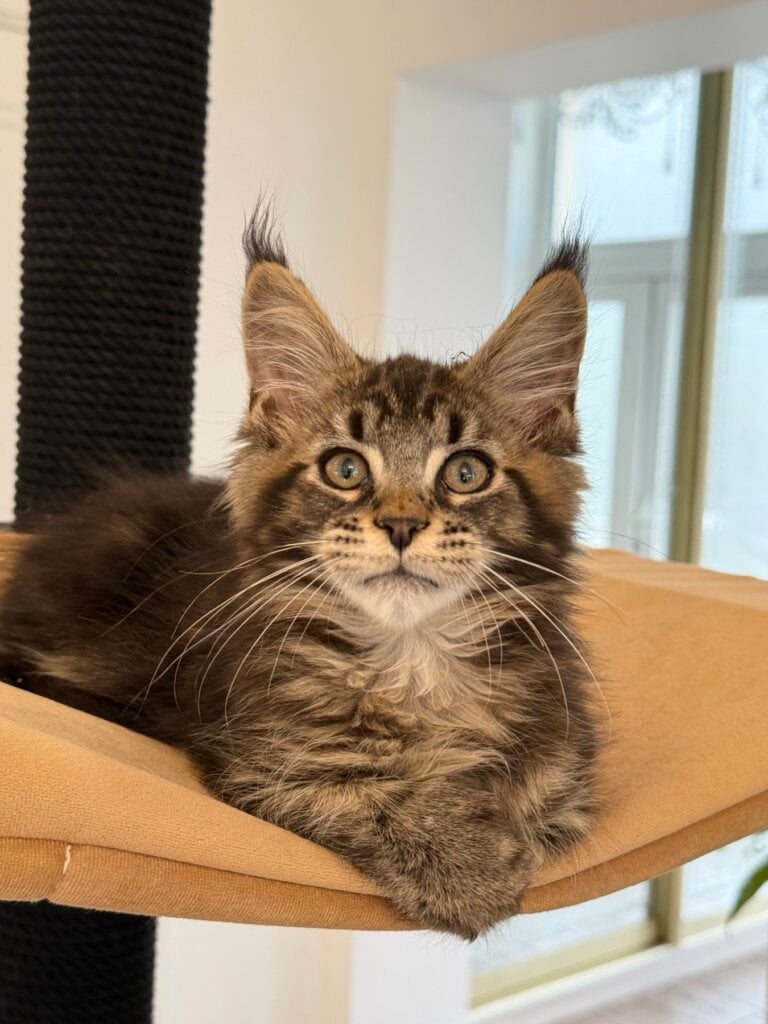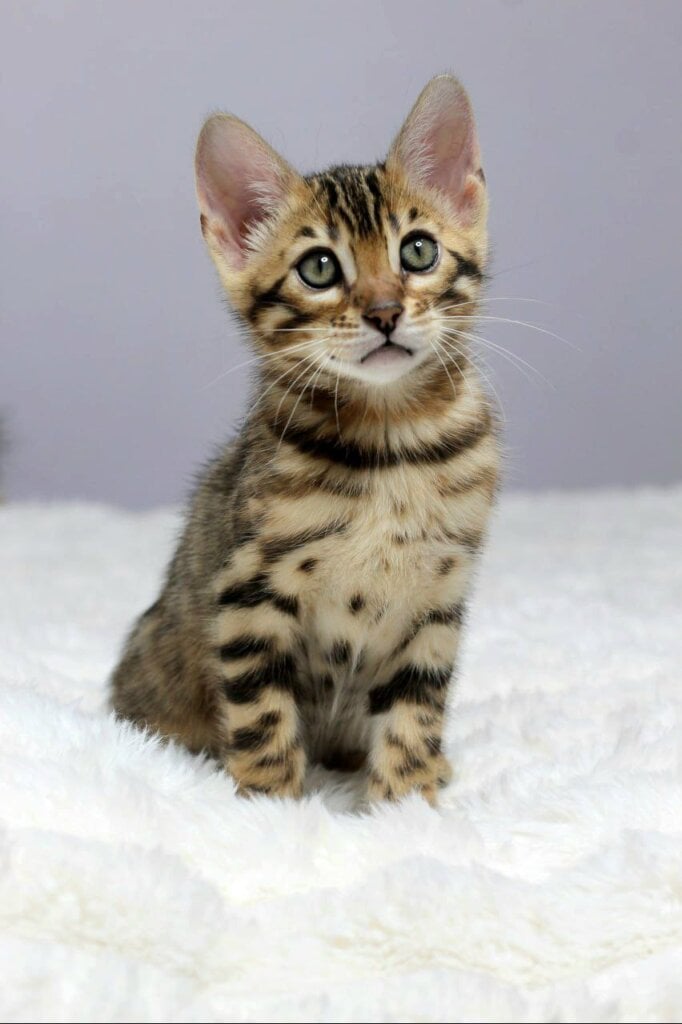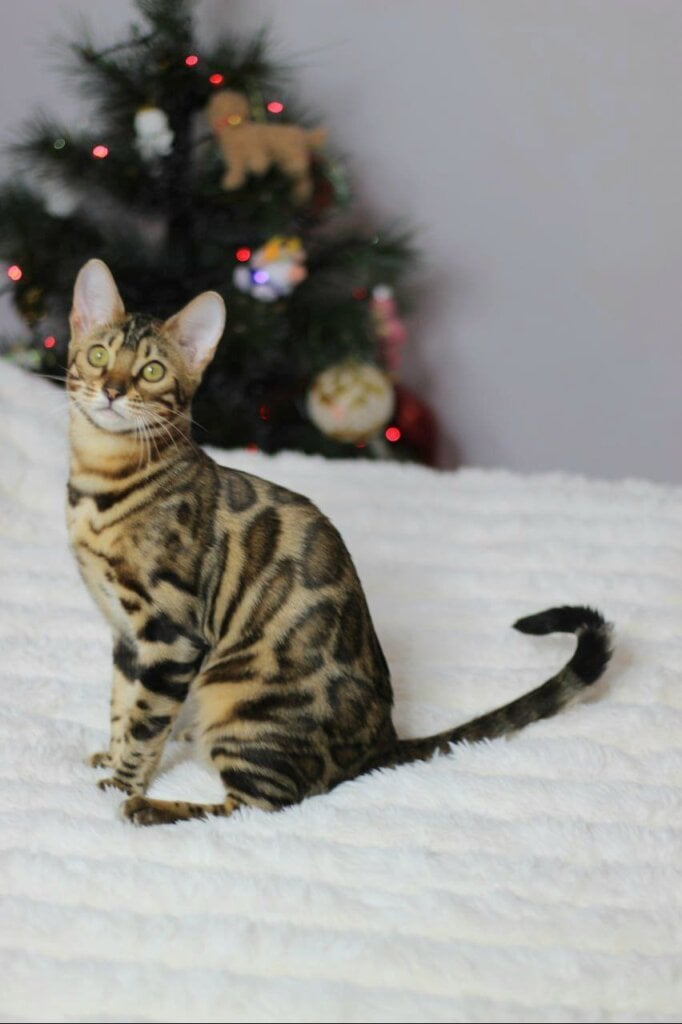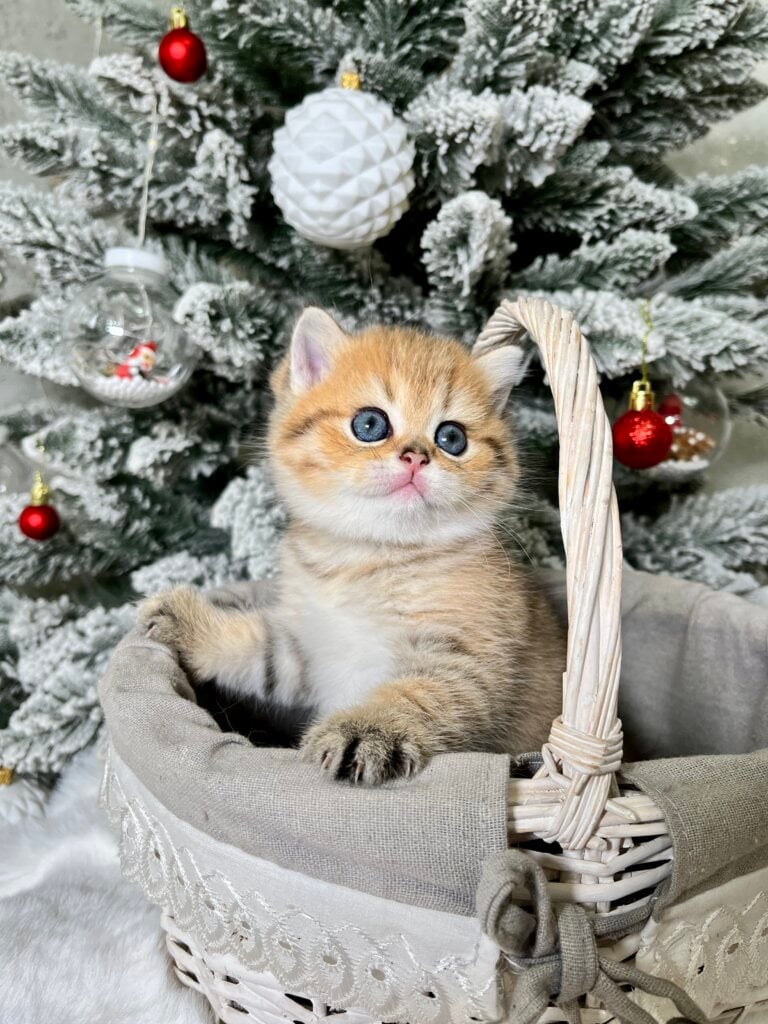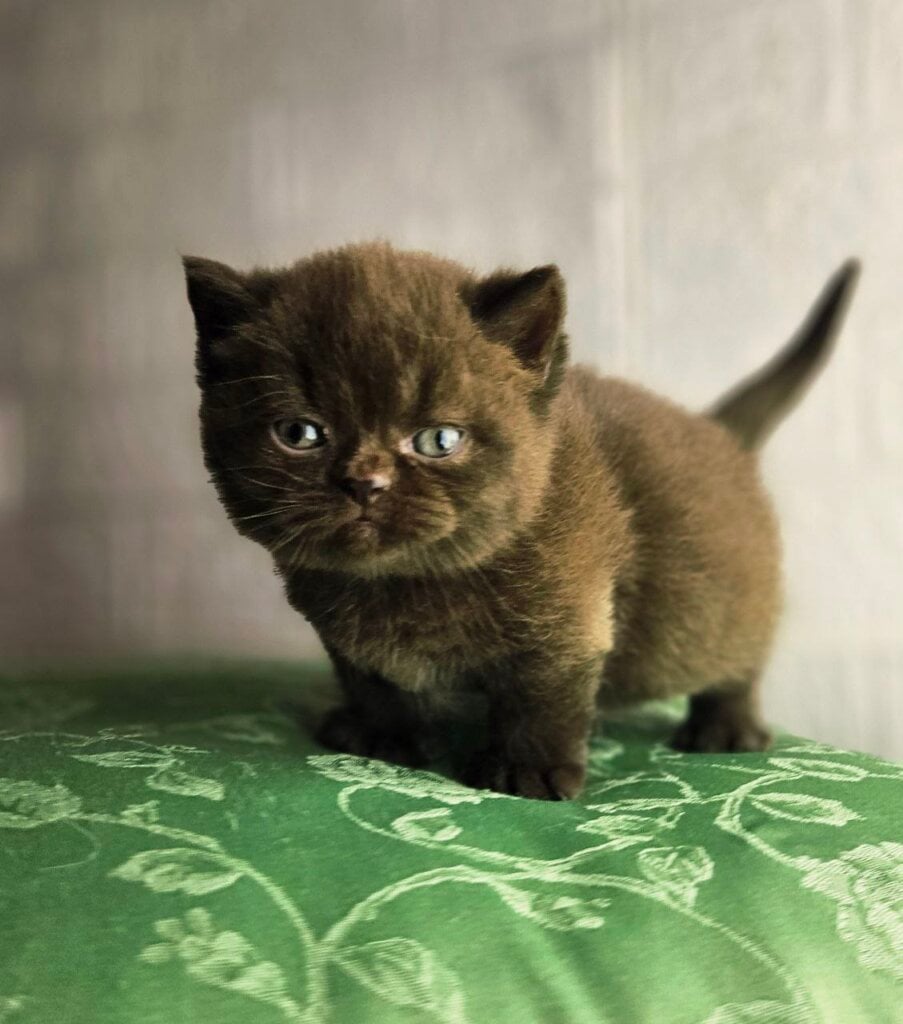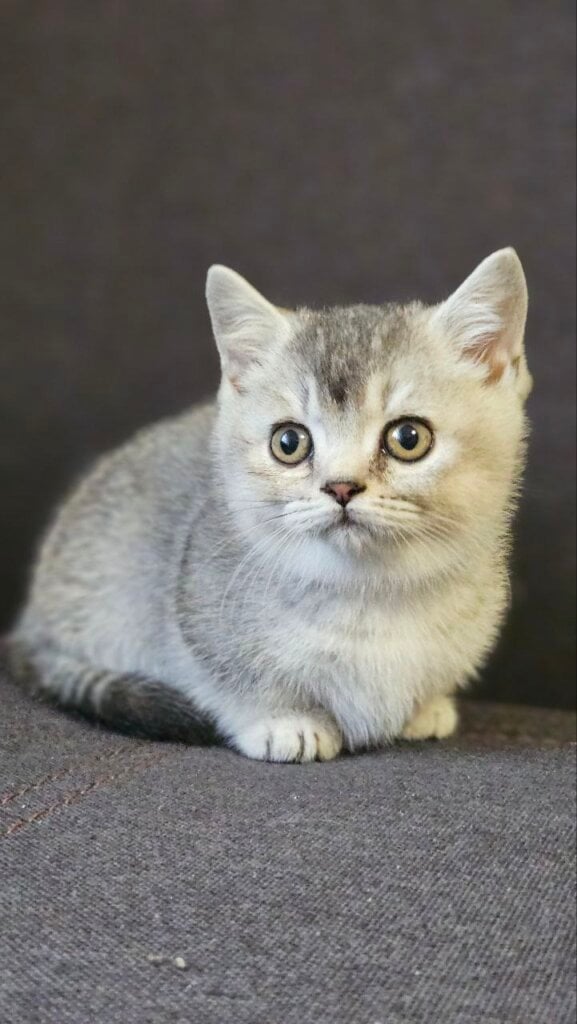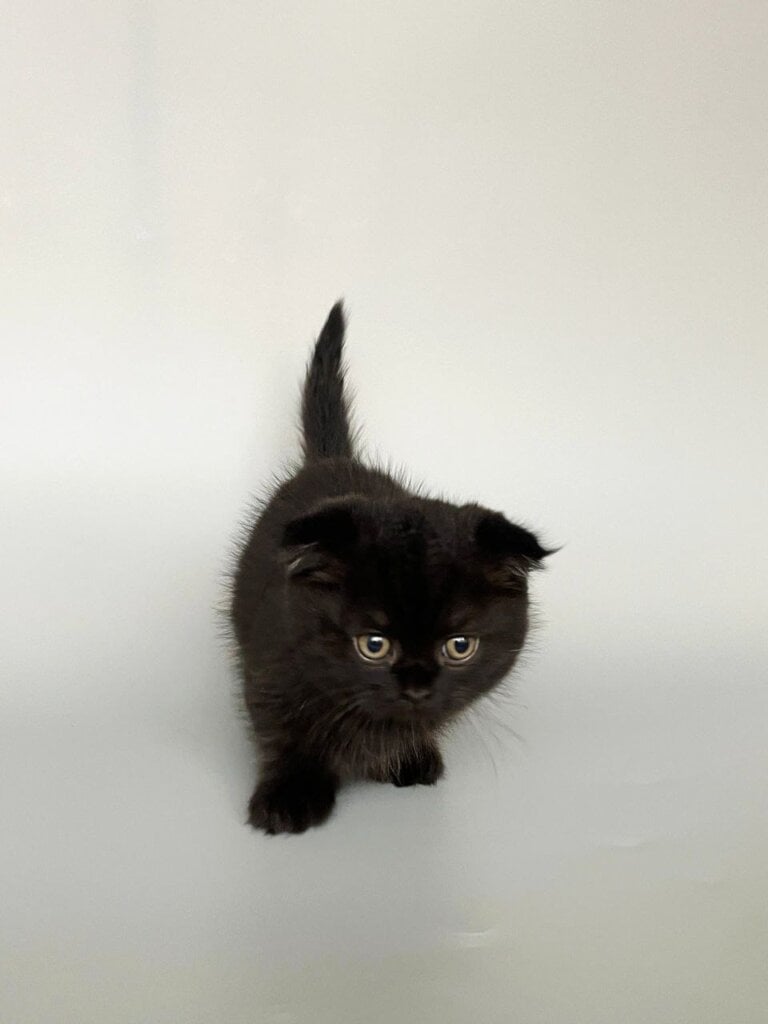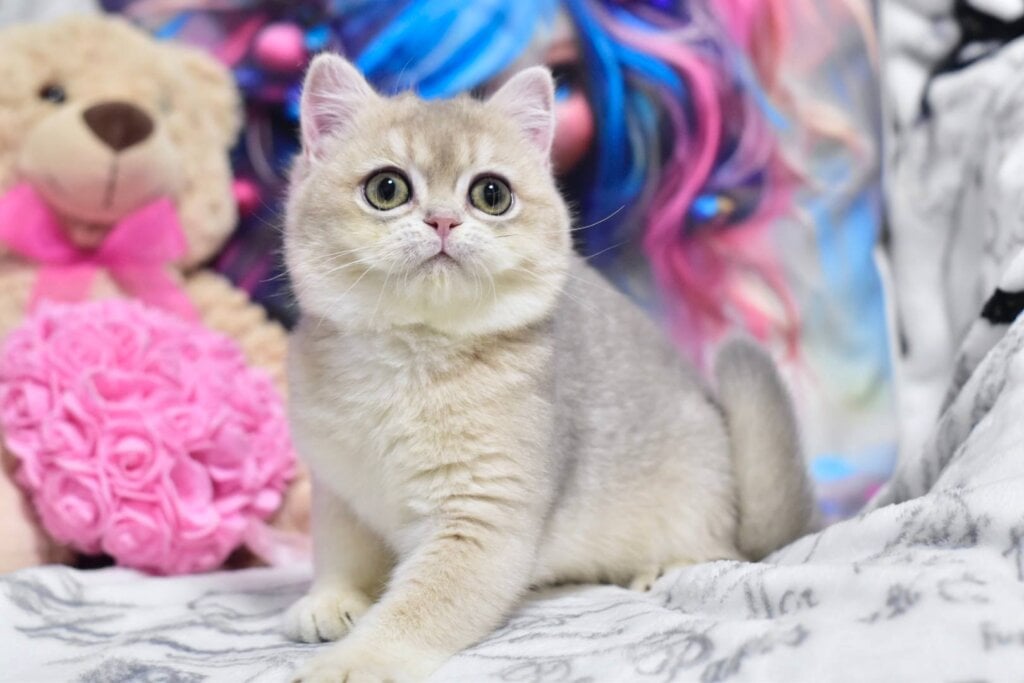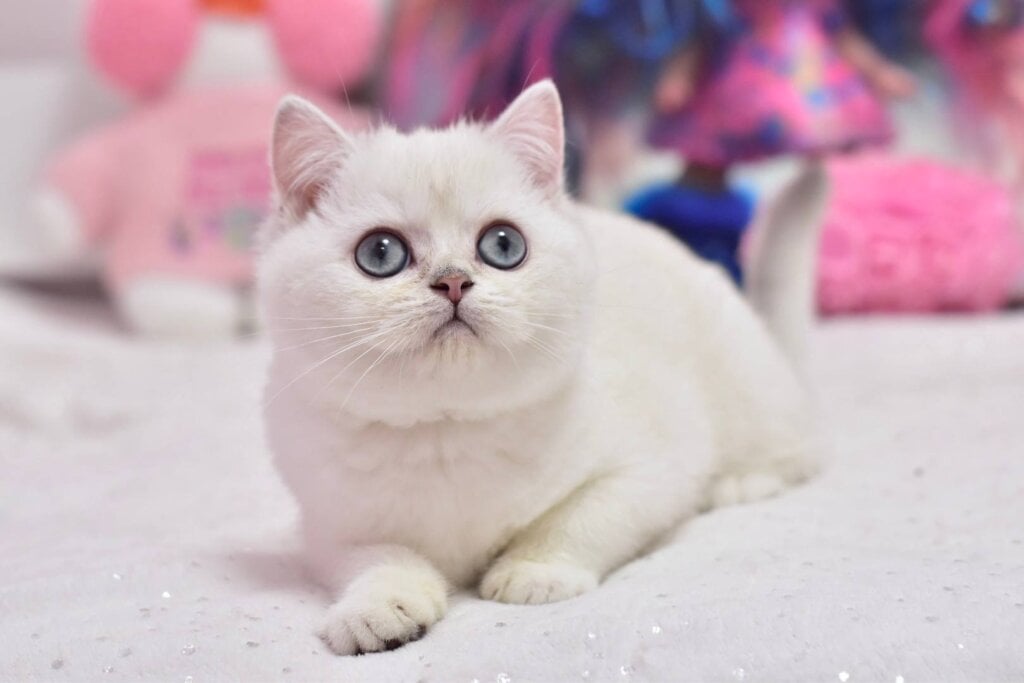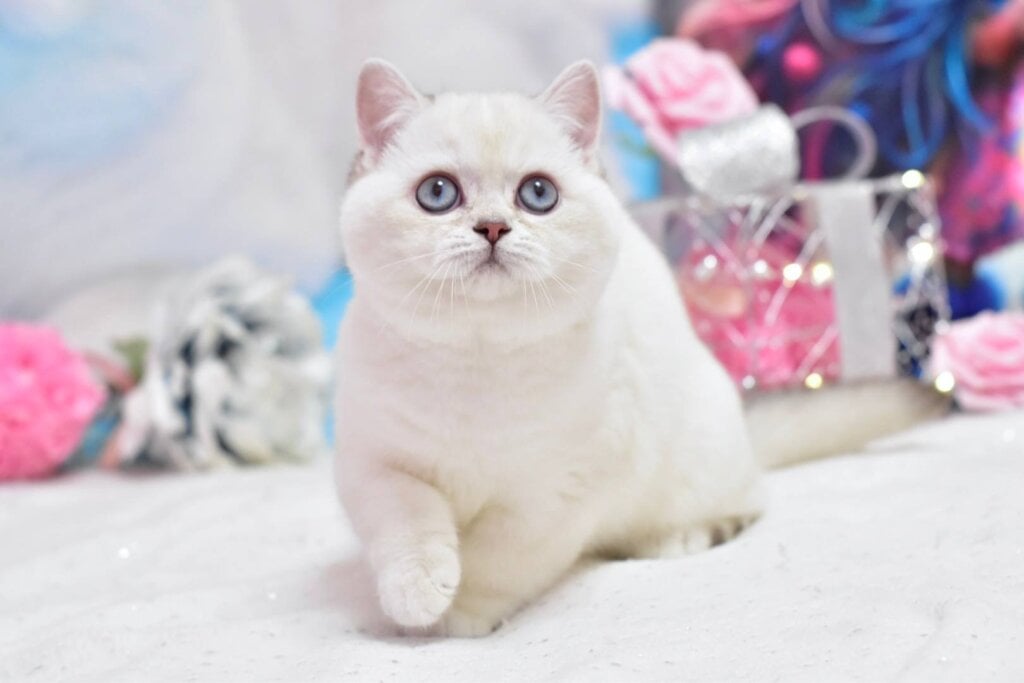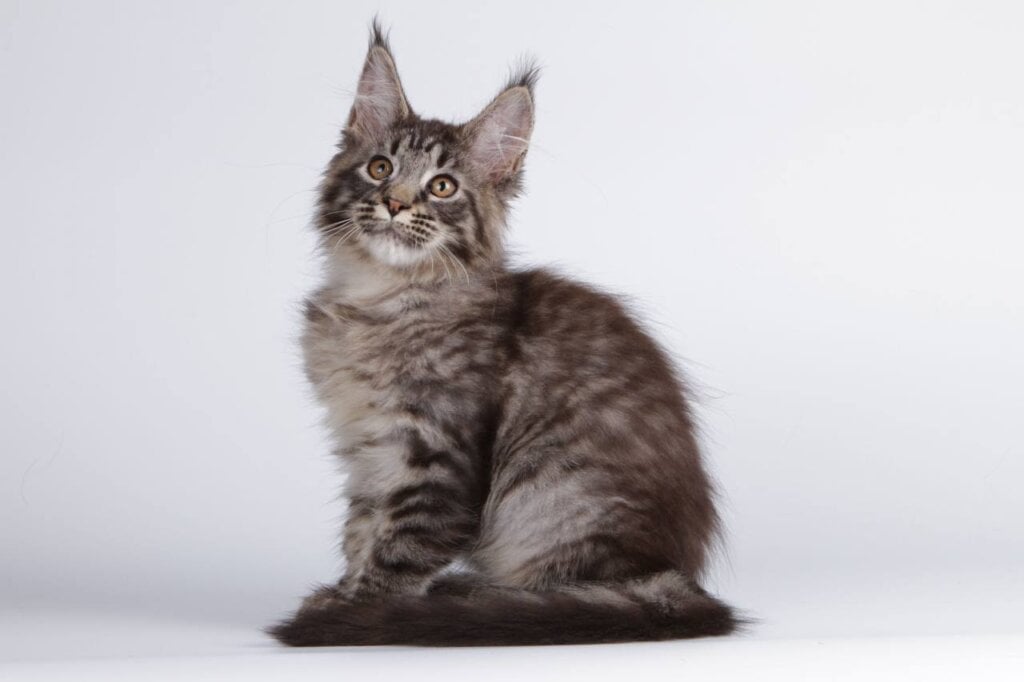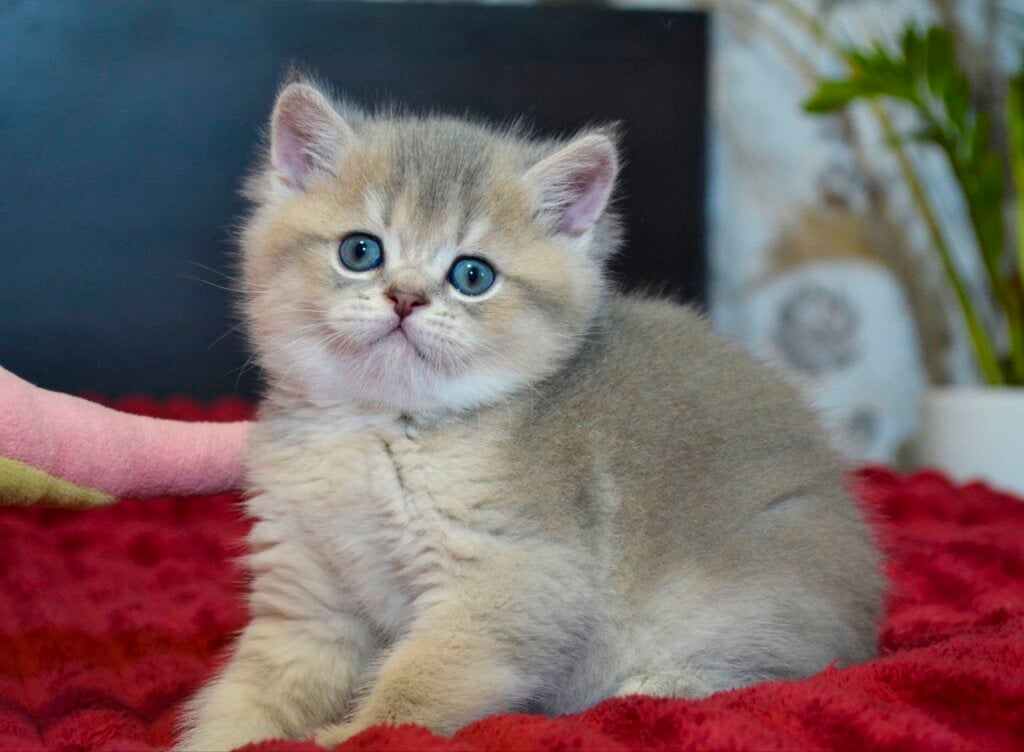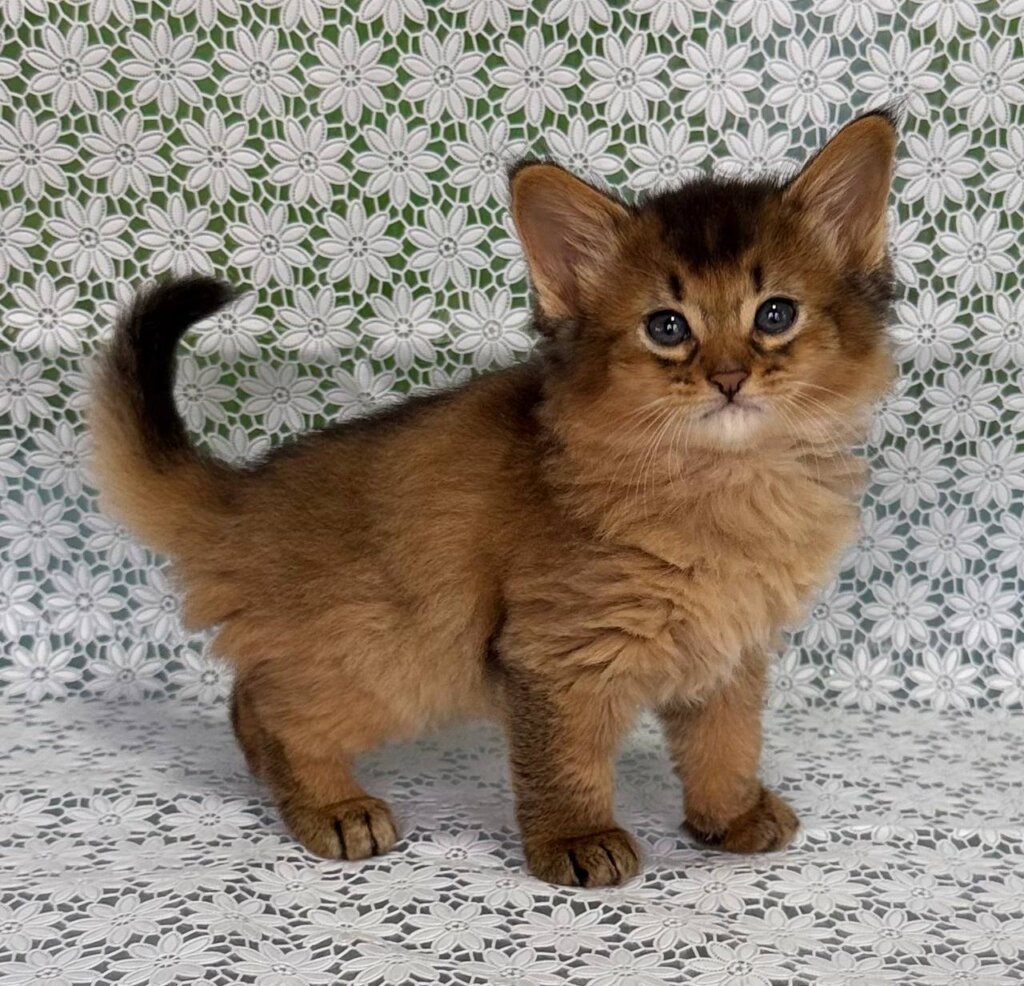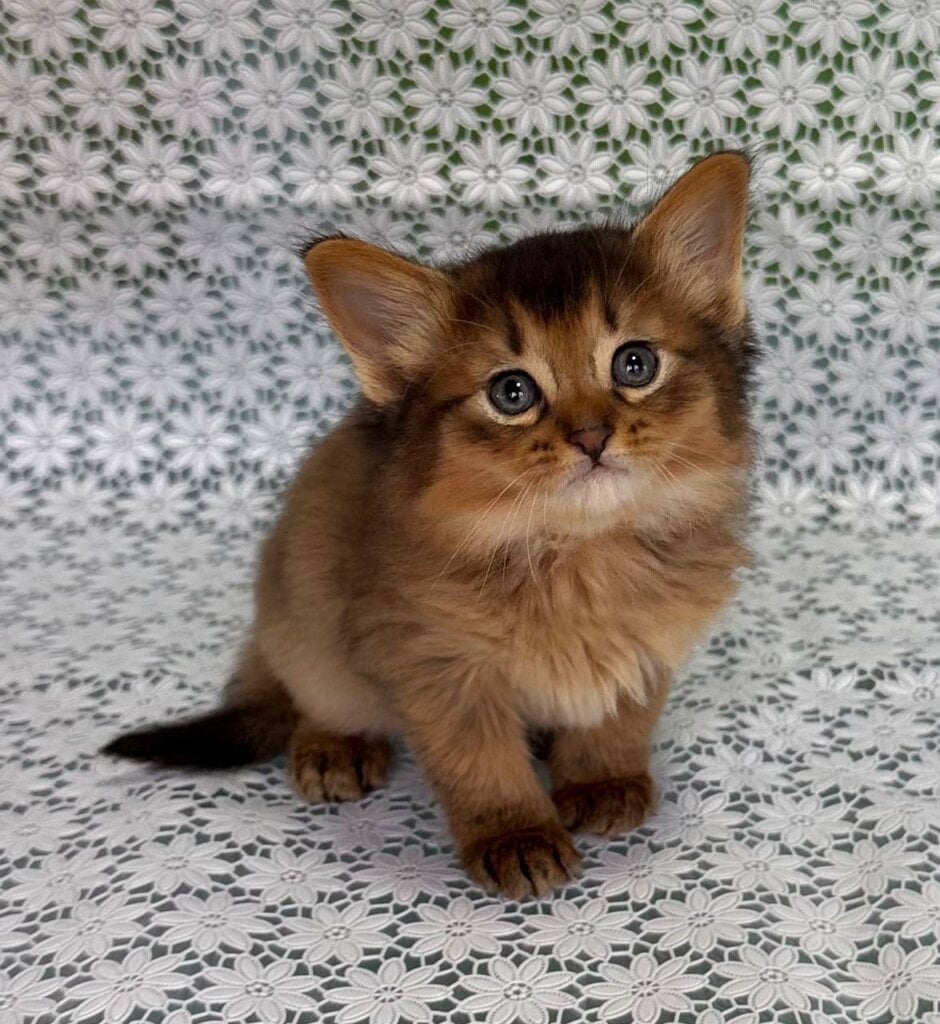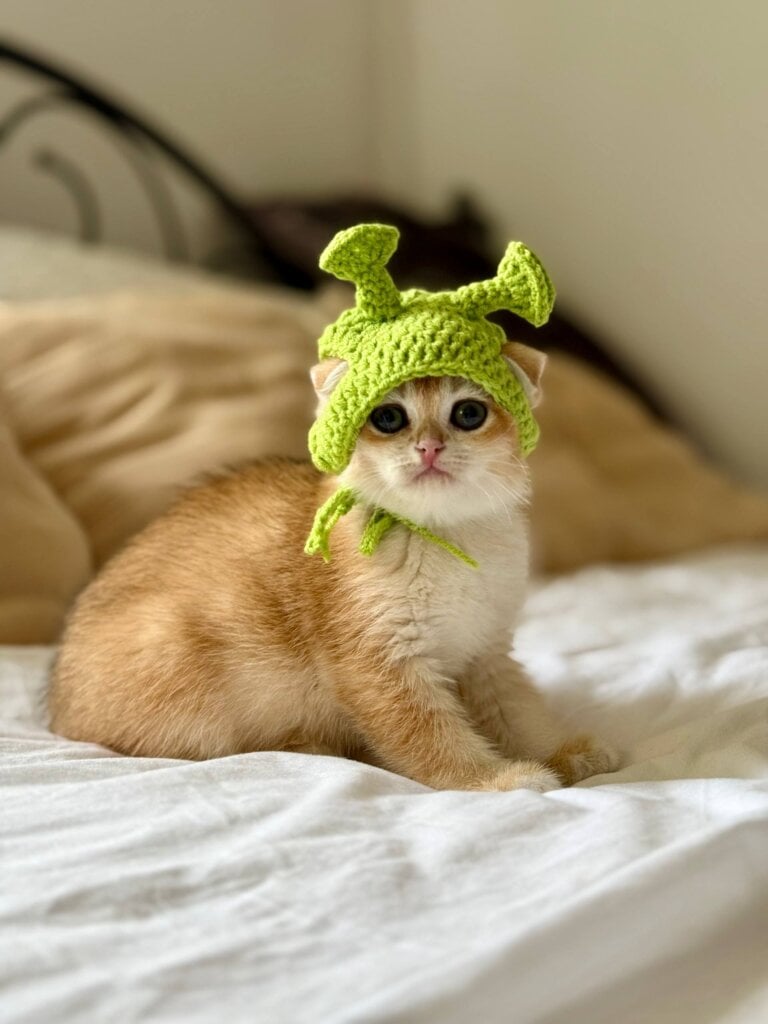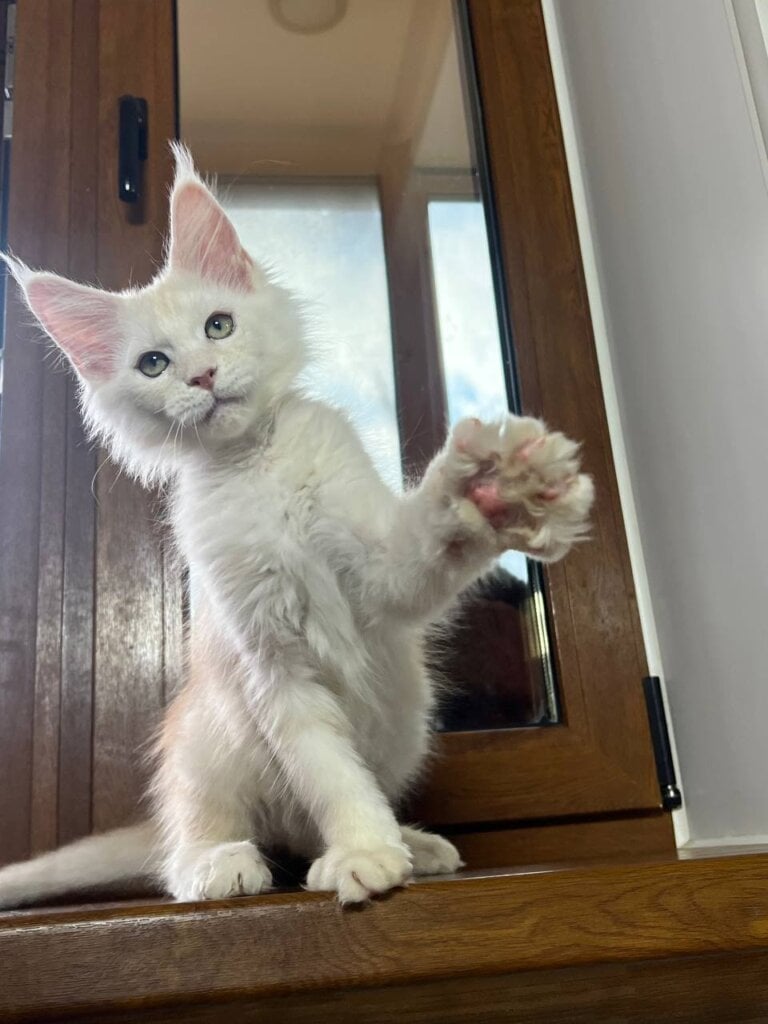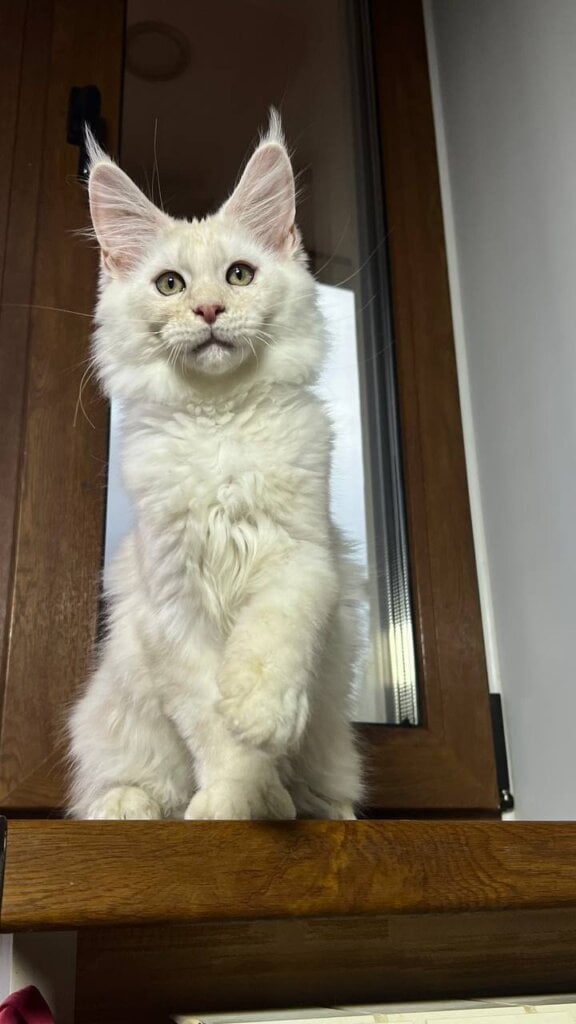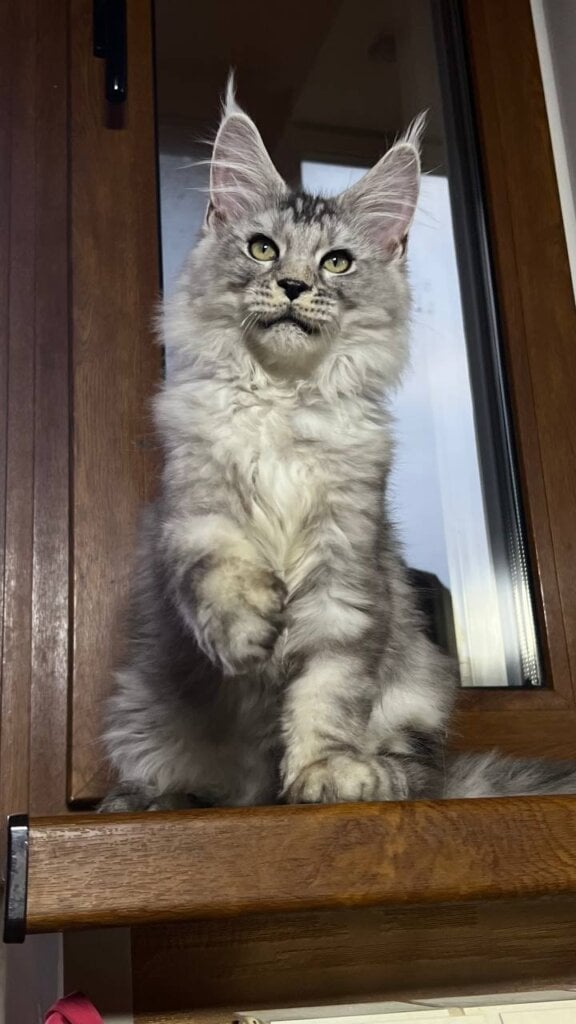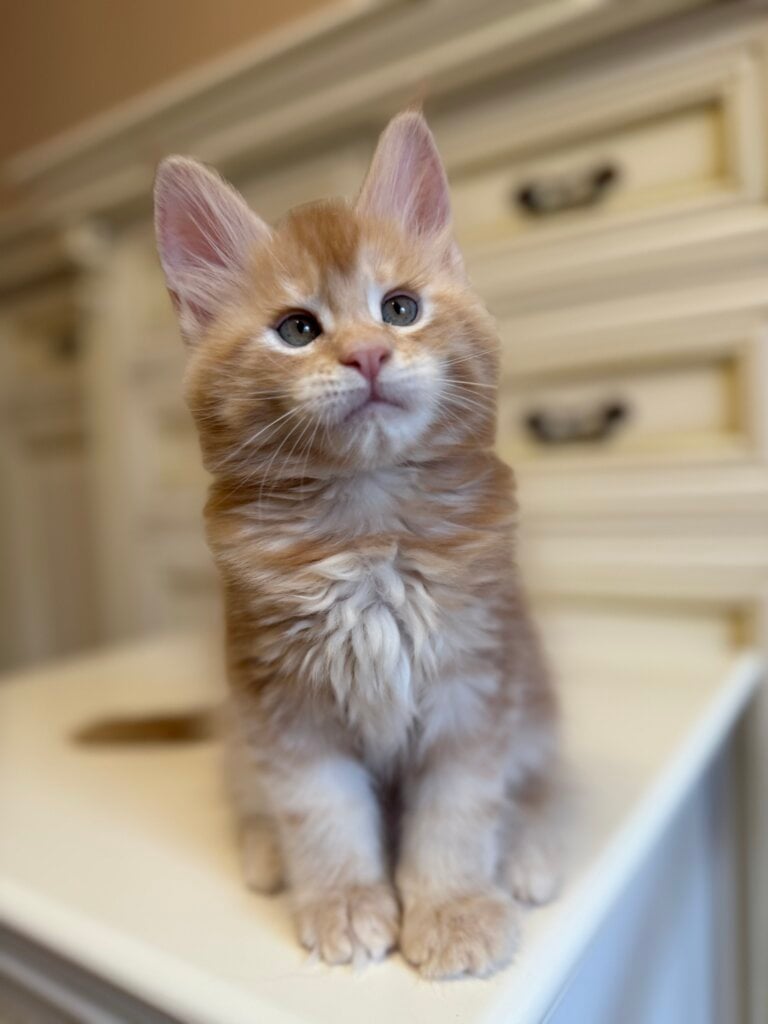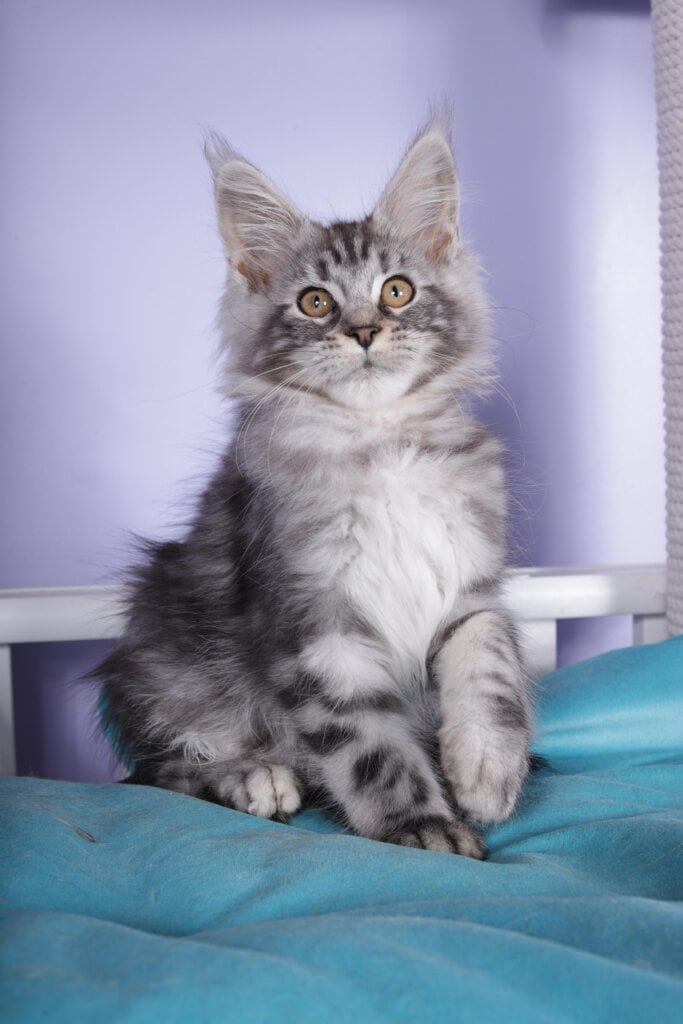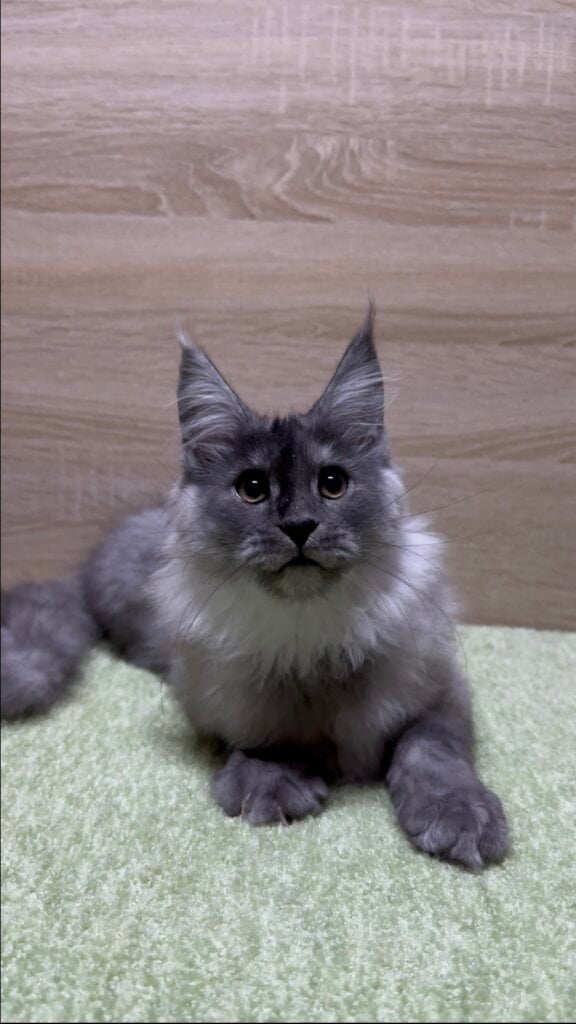British Shorthair cats are available in a variety of color options, spanning from blue and lilac to cream, white, black, and even chocolate. A few cats exhibit solid colors, whereas the rest display markings such as tabby, bicolor, or colorpoint.
These hues and motifs are accepted by breed standards. Each kitten’s appearance is dependent on the genetics of the two parents. In the following passages, discover which colours and patterns render British Shorthairs so adored.
The British Shorthair Colour Palette
British Shorthair cats are diverse in color and pattern, which is a testament to both their ancient lineage, as well as the efforts of breeders. Their coats may be solid, patterned or even multicolored, with each adding a certain magic to the breed’s appearance and appeal. This variety is why we all love our British Shorthairs so much!
Here’s a run down of the main colour varieties you’ll encounter in this breed.
- Classic Solids: Includes blue, black, and white, with variations in eye color and genetic background.
- Warm Solids: Covers shades like red (ginger) and cream, each with its own pigment depth.
- Dilute Solids: Features paler versions of classic colors, such as lilac and fawn, shaped by the dilution gene.
- Tipped & Shaded: Coats show a lighter base with darker tips or shadings, creating a unique effect.
- Patterned Varieties: Includes tabby, tortoiseshell, and colorpoint patterns, each needing specific genetics.
- Multi-Coloured Coats: Tortoiseshell and bi-color cats have coats with two or more distinct colors.
1. Classic Solids
Note that classic solids form the basis of the British Shorthair palette. Blue is the most iconic, commonly referred to as the ‘British Blue’ or ‘English type’. These cats have a dense blue-grey coat and typically copper or gold eyes.
Black and white solids are common with black British Shorthairs having ink black, shiny coats and white ones being snow white with copper, blue or odd-eyed eyes. Genetically, solids are governed by one color gene.
The dilution gene is instrumental, particularly with blue cats, as it ‘softens’ black into blue. These traditional colors are industry staples and loved for their deep, uniform hue.
2. Warm Solids
Warm solids, such as red (ginger) and cream, create a comfy, welcoming look. With red British Shorthairs sporting scarlet coats, cream cats are gentler and lighter.
These are the colours that come from pigment genes that darken or lighten the coat’s tone. Copper or gold eyes are typical for these warm-hued cats.
Warm solids are rarer than blues or blacks and cherished by breeders and collectors alike for their warmth.
3. Dilute Solids
Dilute solids are the ‘lighter’ counterparts to classic colors thanks to the dilution gene. Not rich black or red, but lilac-soft pinkish-gray-or fawn, warm beige.
These shades are muted, lending the cats a faded, pastel appearance. Lilac and fawn British Shorthairs are popular for people who prefer something a little different than the traditional colors.
Though their coloration is more subtle, the appeal is irresistible. The dilution gene has to be in both parents, which is why these colors are less common and tend to be more costly.
4. Tipped & Shaded
Tipped and shaded coats feature a pale undercoat with dark tips, resulting in a shimmering appearance. Tipping means that only the absolute ends of the fur are colored and shading means that a larger proportion of the hair length is dark.
These effects arise from particular genes that restrict pigmentation to segments of the hair shaft. With tipped or shaded coats, these cats are distinguished by their graceful and distinctive appearance.
This colour type is very much liked by the fancy cat folk.
5. Patterned Varieties
British Shorthairs with patterns are tabby, tortoiseshell, and colourpoint. Tabbies display stripes or swirls, tortoiseshells combine black and red, and colorpoints feature darker extremities.
Each has a gene set needed so some are more difficult to breed. They’re striking cats and add some diversity to the breed.
The patterned types are most popular with people who desire a unique, whimsical look in their companion.
6. Multi-Coloured Coats
Multi-colored British Shorthairs, such as tortoiseshell and bi-color, possess two or more distinct colors. Torts are usually black and red, bi-colors combine any solid with white.
Their genetics are complex, often involving sex-linked genes, so they are less predictable in litters. These coats are valued for their uniqueness and beauty.
To breeders, tri-coloured cats are a temptation and joy.

Beyond Solid Hues
British Shorthair cats aren’t just blue-gray – their coats can exhibit a diverse array of patterns and markings extending well beyond solid hues. These patterns add interest, emphasize the breed’s plush fur and make every cat unique in appearance. Genetics, of course, pass down everything from tabby stripes to shaded tips, with each pattern adding to a cat’s charm.
Patterned British Shorthairs, such as bi-color, tri-color, tabby, colorpoint and others, each have distinct characteristics and charm for families desiring something special.
Tabby Patterns
Tabby British Shorthairs are available in classic, mackerel, spotted, and ticked patterns. Classic tabby uses bold, swirling shapes and a bulls-eye on the side. Mackerel tabby displays narrow, vertical stripes on the body.
Spotted tabby is, well, spotted, and ticked tabby has a sand-like appearance with no apparent stripes. All tabbies have an ‘M’ on the forehead, dark lines from the eyes, and distinct striping or spotting on the legs and tail.
These can be strong in kittens but fade as the cat matures, though some ghost stripes stay. What’s great are these lines and swirls that play with the light and make the fur look alive. Tabby patterns are inherited, delivered through the agouti gene.
This gene toggles bands of color on each hair, resulting in the cellular or marbled appearance. Tabby British Shorthairs are some of the most popular with cat lovers, owing to their timeless appearance and the warm, mischievous aura the stripes appear to emit.
Colourpoint
Their coat is mostly a lighter color, but as Colourpoint British Shorthairs, the colour on their ears, face, paws and tail is darker. This appearance ties back to Siamese cats but is now firmly established in British shorthairs.
The colourpoint gene is recessive, so both parents must possess it. Colorpoint kittens are born white or pale and colour comes in as they grow. Colourpoint cats are dramatic, with a strong contrast of body and points.
There are several types: classic color points, bi-color color points, tabby color points, tortie color points, silver (smoke) color points, and shaded and shell color points. Colorpoint British Shorthairs are a prized find. Their incredible appearance combined with their sweet temperament makes them a household favorite for families desiring something different.
Tipping & Shading
Tipping means just the tips of the hair are colored. Shading implies that greater part of the hair, but not the whole, is dark. Both add to the coat a gentle, misty appearance.
These accents provide depth and shimmer, causing the coat to appear to change in the light. Tipping and shading are from the inhibitor gene, which prevents color from continuing down each hair.
Shaded and shell color points are a treat. Only a 1/8 of each hair is colored the rest white/cream. This creates a sparkling effect that’s understated but beautiful.
The Genetics Behind the Coat
A British Shorthair’s coat is sculpted by a blend of color-, pattern-, length- and even texture-controlling genes. These genes don’t act in isolation-they swirl and swirl and collide to make a cat one-of-a-kind. For breeders, understanding how these genes interact helps them select partners that will produce offspring with the most desirable or rare colors, all while sticking to breed standards.
The table below demonstrates some genetics behind British Shorthair colour variation.
| Gene/Locus | Main Function | Impact on Color |
|---|---|---|
| Agouti (A/a) | Controls pigment banding in hair | Tabby patterns or solid |
| Browning (B/b/bl) | Influences black/brown pigment | Blue, chocolate, lilac shades |
| Orange (O/o) | Controls orange/red pigment, X-linked | Red, cream, tortoiseshell |
| Tabby (Ta/Tb/Tm) | Creates various tabby patterns | Classic, mackerel, ticked |
| KIT | Influences white spotting/patches | Bicolor, van, harlequin |
| Dilution (d/d) | Lightens base colors | Blue, lilac, fawn, cream |
Dominant Genes
Dominant genes such as the Agouti (A) and browning (B) genes have caused some colors and patterns to be more prevalent. If a kitten inherits even one dominant gene from a parent, it will display that characteristic. For instance, the dominant Agouti gene provides the traditional tabby stripes, whereas the dominant black gene would typically result in a solid blue or black coat when undiluted.
Breeders typically select cats with dominant traits to boost their chances of breeding kittens in fashionable colors. For families that wish a good old fashioned British Blue, dominant genes simplify this. Classic blues and blacks are dominant, so they appear frequently and consistently.
Recessive Genes
Recessive genes such as chocolate (b), lilac (bl) and dilution (d) have to be inherited from both parents for a kitten to possess these uncommon colors. This is the reason chocolate or lilac British Shorthairs are scarcer-they come about only when both parents possess the gene.
Breeding for recessive colors requires patience. For example, breeders might breed two carriers so that it will express itself in the kittens. The trick is keeping these rare colors healthy and in the breed standard, as working with recessive genes can risk shrinking the gene pool.
Certain uncommon colors, such as cream or fawn, can only occur with two recessive genes involved.
The Dilution Factor
The dilution gene (d) takes bold colors and whispers them-they turn black to blue, red to cream, chocolate to lilac. It’s a subtle yet dramatic difference and it’s what makes blue British Shorthairs so beloved.
Dilutes tend to have a plush, powdery appearance that captivates feline enthusiasts worldwide. The most common diluted colors in British Shorthairs are blue (diluted black), lilac (diluted chocolate) and cream (diluted red). There’s something inherently sweet and timeless about these mellow colors!
Understanding EMS Codes
EMS codes are the international coat color and pattern naming system for cats. Each code represents a color, pattern or characteristic, such as ’BRI a’ for blue British Shorthair.
Breeders and cat shows utilize these codes to organize and evaluate cats, facilitating the tracking of genetics and breed standards. If you’re interested in adopting or showing a British Shorthair, knowing how to read EMS codes can be helpful for breeders when planning litters and keeping records clear.
Rare and Developing Colours
British Shorthair cats are now available in more than 250 colors, and the hues keep developing. Certain colours are rare or emerging and highly sought after by collectors, breeders and pet enthusiasts. It takes deliberate breeding and time and patience to arrive at these colors, because true color in kittens can take up to 1.5 years to develop.
The table below shows main breeder challenges:
| Challenge | Detail |
|---|---|
| Genetic unpredictability | Genes affecting color can combine in unexpected ways |
| Registry rules | Not all colors are accepted by every cat registry |
| Health considerations | Ensuring rare color breeding does not impact kitten wellness |
| Slow color development | Full color appears only after 1-1.5 years |
| Market demand | Meeting collector demand for rare colors without overbreeding |
Golden Hues
Golden British Shorthairs are easily recognized for their warm, shimmering coats. These cats exhibit gold, honey or apricot hues, occasionally with faint tabby striping. These colours develop from a complicated combination of genes which regulate pigment, in particular the ‘wide band’ gene, which lends a luminescent appearance to the coat.
Golden colors are uncommon as the genetics are unpredictable and the color intensifies as the rabbit ages. Kittens can appear washed out but glow more with age. Collectors and cat shows prize these cats for their unusual appearance and velvety plush coat.
The golden effect is particularly captivating against the traditional British Shorthair round face and copper eyes. As so many other breeders, mine considers golden one of the most flashy and desirable colors nowadays.
Cinnamon & Fawn
Cinnamon and fawn are very new colors to the British Shorthair world. Cinnamon is a warm reddish brown and fawn is a soft light beige. These colors are from recessive genes so both parents must carry the gene for kittens to display the color.
THAT’S why cinnamon and fawn British Shorthairs are so uncommon. They’re not always accepted by all breed registries, though some such as GCCF and FIFe now do. Most cat lovers fall for these hues because of their delicate, uncommon appearance.
Cinnamon and fawn cats may be solid or patterned, providing even more diversity to the breed.
Breeder Innovation
Breeders employ selective breeding to craft and polish new colours. By mating cats with rare genes, they can gradually phase them in and fix them in a healthy manner. Ethical breeding means prioritizing kitten health, not trend-hopping.
Colors in innovation are continuously developing. Breeders have genetic screening, stud book guidelines and pet parents and enthusiasts to satisfy. Emerging colors, such as chocolate, lilac, cinnamon and fawn, prove the breed keeps developing.
The future will no doubt bring even more shades, as breeders juggle beauty vs. Health and ethics.
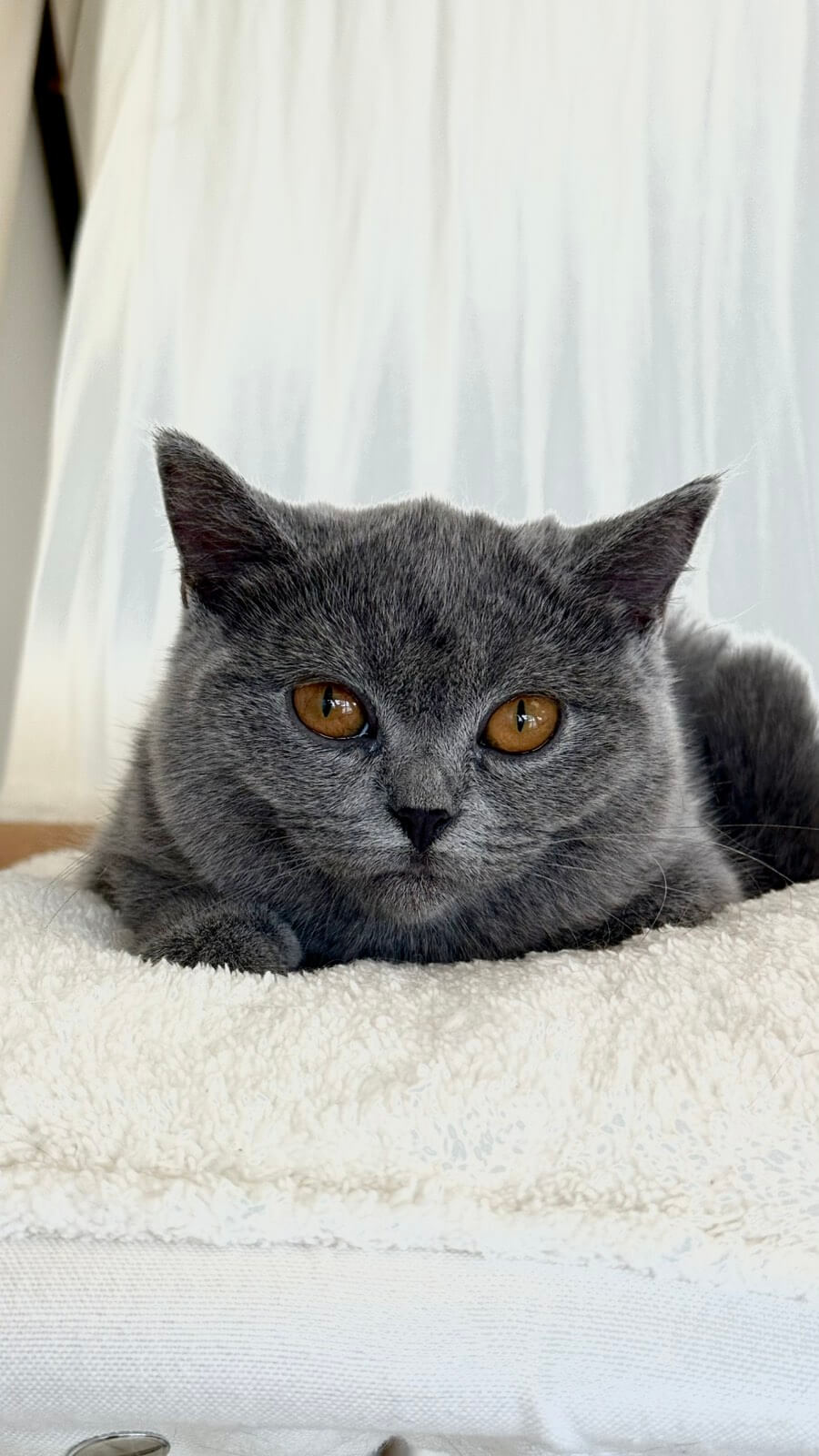
Does Colour Affect Temperament?
British Shorthair cats are available in a lot of different colors, yet many people question whether that coloring reflects on the temperament of these cats at home. Although certain colors are said by some breeders and owners to have particular personalities, there is no definitive evidence that color influences a British Shorthair’s temperament.
Rather, every cat’s temperament is more of a genetic thing, and depends on how it was raised and treated and socialized. Certain owners claim that blue or lilac Brits appear more placid. Some believe black British Shorthairs behave more playfully. White British Shorthairs are sometimes described as more reserved. Most breeders will say fawn and lilac cats are docile, but so are some others. All kittens are busy and fizzy until they get older and more mellow.
The Colour Myth
I always assumed that one’s cat’s color influenced its personality. Legends like ‘blue cats are always sweet’ or ‘black cats are mischievous’ have existed for decades. These concepts do commonly influence human selection of a kitten or even breeders’ decisions, but they don’t have a lot of support in actual research.
The majority of these myths stem from anecdote and folklore, not science. When we anticipate color to behave in a certain way, we begin to observe what we expect. This can cause stereotypes and make it more difficult to recognize each cat as an individual. Certain colors may even be emphasized by some breeding programs for these reasons, but it’s more crucial to consider a cat’s health and temperament.
What counts is how a cat’s brought up and the treatment it receives, not the colour of his fur.
Personality Over Pigment
Personality trumps pigment in British Shorthairs. Each kitten is a personality, regardless of the color it dons. The primary factors influencing a cat’s temperament are its genetics–inherited characteristics from the cat’s parents–as well as its socialization and environment in which it is raised.
A well socialised kitty, which has been handled cautiously from an early age, will almost certainly mature into a self assured loving adult. British Shorthairs, whether they’re blue, black, fawn, lilac or white, are famously even-tempered, affectionate and easy to live with. The breed’s temperament is a more reliable indicator than any coat color.
Early exposure to humans, and good handling, make any British Shorthair – regardless of color – a superb companion. A cat’s age is also important. They’re like kittens – a little too peppy and bouncy – then they’ve grown into a mellow adult nature. Color doesn’t alter this process. What matters is how each kitten is cared for and adored throughout its life.
The Evidence
No, there are no scientific studies that link coat colour to temperament in British Shorthair cats. Breeder and owner anecdotes may vary, but they can’t substitute for rigorous research.
So picking a cat by color might leave you passing over the perfect match. Consider character, fitness and training when selecting your new mate.
A Breeder’s Perspective on Colour
Color & Pattern – British Shorthair cats come in a variety of colors and patterns. For breeders, colour isn’t merely cosmetic. It informs decisions, health initiatives, and the breed’s destiny. Good breeding is about more than selecting beautiful shades-it’s about behaving thoughtfully and intelligently.
Preserving Standards
Breed standards lay down the road to British shorthair-hood, right down to the tone and intensity of coat color. These guidelines, established by international organizations such as the WCF and TICA, ensure that the breed maintains its expected appearance and behavior.
When breeders adhere to these guidelines, the breed maintains its established shape and earns the confidence of cat enthusiasts. If breeders disregard standards, the breed’s reputation suffers. Buyers might lose confidence and the special identity of the British Shorthair would become indistinct.
Cat associations act as watchdogs here-they check pedigrees, survey breeding programs and maintain databases. The most difficult for us breeders is managing to maintain the classic blue or lilac, and generatively add new, uncommon colors. It’s an art to combine them both without diluting what makes the breed unique.
Health First
- Health screening checklist:
- DNA testing for inherited diseases (like PKD).
- Testing for typical viruses.
- Testing for color-linked genetic defects (e.g., white cats).
- Going over family history of health.
- Standard vet exams prior to breeding.
Certain colors may indicate health concerns. For example, white cats are more prone to deafness and specific dilute colors often have accompanying coat/skin issues. That’s why health checks are not just a formality-they are key.
Skipping health testing jeopardizes kittens and the breed’s future. As breeders, we need to prioritize health over appearance. Healthy cats will find a way to bring more happiness and spend more years happily with families.
The Rarity Factor
Rare colors, such as chocolate or cinnamon, are attention grabbers and frequently sell for a premium. This appetite can seduce breeders to cater exclusively to what’s scarce, even if that means skimping.
Pursuing fresh hues may push breeding decisions that damage health or violate breed standards. The proper way is to mate ethics and standards. Breeding for rare colors should never mean skipping health tests or mushing in traits that aren’t British Shorthair ideals.
Scarcity is thrilling, but it should never take precedence over the cats’ welfare. It’s a delicate balance, and savvy breeders understand where to best place it.


